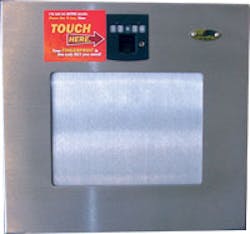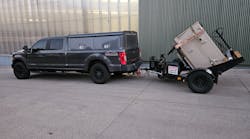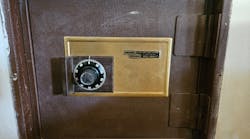Recommended service to change a safe battery(s) once a year is good, if not great, idea to have as part of a service contract with your customers. This can be an annual “safe” checkup for the entire home, office, etc., which includes making sure the locks properly operate, adjusting door closers, and doing a site inspection for the customer’s safety. Even if you do not have a contract, keep a record and mail a post card or call once a year to keep your name in front of your customer.
NOTE: Use brand name alkaline batteries unless the manufacturer recommends something different. Extra heavy duty batteries are not alkaline.
Although many electronic safe locks are capable of operating using the same battery for more than one year, safe owners tend to not replace the battery(s) even after the “low battery” warning signs have stopped.
The customer will almost always call on a pre-weekend/holiday afternoon, saying they must have the safe opened within the next three hours (sometimes two) because it is the event of the century and the safe you sold them does not work.
The opening problem is almost always one of two scenarios. Either the combination has been lost or misremembered, or the battery(s) are dead to the point the combination can not be entered in order to unlock the safe door (and the owner will usually deny that he or she is using the safe even after hearing and/or seeing the warning indicators).
If you have not sold the safe, you probably will not know the make and model of the safe or the lock. As a result, you may not know how to service the safe before you see it. Ask a few questions. Is there a name on the lock? Some safe manufacturers place their name on the lock instead of leaving the lock manufacturer’s name. Another change is changing the lettering on the keypad. One lock manufacturer has changed from having “CLEAR” and “ENTER” back to “*” and “#”.
One of the ways some safe producers cause headaches for locksmiths is by changing the name and part number on a safe. The safe itself has not been changed. A new name and part number are introduced to stimulate sales. This can cause confusion in being able to identify a safe. Look at the following safes. If your safe appears to be physically the same as one of listed models but the name or part number is different, consider attempting to follow the information in order to replace the battery(s) or to unlock and open the container using the key lock override.
If the batteries are externally mounted and there is no mechanical override, try to operate the safe lock. If there is no mechanical override and the lock will not operate, only then replace the all of the batteries. Check the condition of the removed batteries before installing new batteries and trying to operate the lock electronically.
To test a battery, use a voltmeter or multi-meter to check the voltage. Each 9 volt battery should indicate at least 6.6 volts. If a 9 volt battery is below 6.6 volts, replace all of the 9 volt batteries. Fresh 9 volt batteries will have voltages of 9.2 volts or more. Each AA (1.5 volt) battery should indicate should indicate at least 1.1 volts. If the AA battery is below 1.1 volts, replace all of the AA batteries. Fresh AA batteries will have voltages of approximately 1.6 volts.
When the electronic safe lock has more than one battery, be sure to replace all of the batteries at the same time. If not, the worn batteries will draw current from the new batteries, causing them to become depleted prematurely.
To help solve the problems of safe and/or electronic lock identification, the following are descriptions and graphics of a number of safe and electronic locks. With each safe and electronic lock included, there are methods for replacing the external battery(s) or gaining access to the override key lock in order to open them.
IMPORTANT: Whenever possible, open the door and throw the bolt before changing the battery(s). Once the battery(s) have been replaced, try the code/combination a number of times before closing the safe door.
Securelogic
Securelogic Biometric Model #20700 and Electronic Pushbutton Model #20710 wall safes are equipped with a rechargeable internal fixed battery. To recharge the battery, there is an external plug on the front of the biometric model or the bottom right corner on the electronic model.
If the safe must be opened immediately, remove one hex screw from the oval metal tag using a 3/32” hex wrench. Turn the tag to expose the four pin tumbler tubular lock.
La Gard LG Basic II Electronic Entry Device
The LA GARD LGBASIC II Model 3715 Electronic Entry Device has a 9 volt battery located within the keypad housing. The keypad is designed to be lifted up in order to gain access the battery compartment. Once the keypad has been lifted off the safe door, unsnap the connector from the battery. Carefully hold onto the battery terminal to avoid pulling wires out of the circuit board. The lock connector cable should run through a slot in the housing. Install the replacement 9-volt alkaline battery. Locate the keypad slots over the two screws in the housing and slide down, making sure no wires can be pinched when the keypad is installed. Pinched cables can result in a short circuit.
La Gard LG Basic II Electronic Combination Lock
LA GARD LGBASIC Model 3710 Electronic Combination Lock is mounted onto the face of the safe. An optional Phillips head screw is mounted at the bottom of the keypad housing. If equipped, remove this screw first. Carefully pull down on the black plastic handle of the battery compartment cover. Once removed, the 9 volt battery and the leads should slide out of the LG BASIC.
IMPORTANT: Do not pull on the battery or the wire leads. Unsnap the connector from the battery and replace with a 9 volt alkaline battery. When secured, slide the battery and the wire leads completely up into the battery compartment. Install the battery cover by placing one side of the cover into position and then press the other side into position with your fingers. Reinstall the Phillips Head screws if equipped.
Liverpool Lock Company
Liverpool Lock Company Safe Model SCS202 has an external battery box. The safe lock is operated by four AA batteries. As a backup there is a battery box with a wired plug that contains four AA batteries. The plug is inserted into the connector on the right side of the keypad. This provides battery power in order to open the safe using the keypad. In addition, an override key lock is beneath the sticker on the door of the safe. Note: The sticker does not come off easily.
Promet Safe
Promet Safe Model SE-25EL is operated by four AA batteries located within the container on the inside of the door. This safe is equipped with a key lock override. The key lock is behind a removable portion of the plastic fascia. That is located along the right bottom of the keypad. The fascia will slide off in a right diagonal angle.
Securitronic
Securitronic Safe Model MT-26NE, a Burg Wachter Safe, is equipped with three AA batteries in an external box that is part of the keypad and boltwork operating handle cover assembly. There is a square plate to the right of the keypad. Insert a straight slot screwdriver into the slot at the bottom of the plate. The plate will lift out. There are three batteries beneath the plate.
Sentry Safe
Sentry Safe Model S6770 is equipped with a four AA batteries in an external box. To gain access to the batteries, slide the rectangular cover towards the right. Once the cover is removed, the four batteries are accessible.
Brinks Firesafe
Brinks Firesafe Safe Model 5190D is equipped with four AA batteries in an external box that is part of the keypad and key lock override assembly. The battery cover slide off towards the right. Remove the cover, then replace the batteries.
Stack-On Safe
Stack-On Safe Model PS-514 safe is equipped four batteries located within the container on the inside of the door. This safe is equipped with a key lock override. The key lock is behind a removable portion of the plastic fascia between the boltwork handle and the keypad. The fascia will lift off, exposing the key lock override.
AMSEC ESL 10 Electronic Safe Lock
The AMSEC ESL 10 electronic safe lock is mounted onto an AMSEC safe. To gain access to the safe lock’s two 9-volt batteries, rotate the keypad counterclockwise until it stops. Then lift the keypad off. Unsnap the connector from the battery. Carefully, hold onto battery terminal to avoid pulling wires out of the circuit board. Install the replacement 9 volt alkaline batteries. Place the keypad against the housing in the off angle position. The keypad should slide into the slot. Carefully turn the keypad clockwise until vertical.
Brinks 5077D Safe
Brinks Model 5077D safe has four AA batteries in an internal battery box. The safe is equipped with a key lock override. To gain access to the key lock override, remove one Phillips head screw from the oval metal tag. Rotate the tag to uncover the double sided wafer tumbler lock. Once the safe door is opened, remove the plastic cover and replace the batteries.
Brinks 5074 Safe
Brinks Model 5074 wall mount safe has four AA batteries in an internal battery box. This safe is equipped with a key lock override that is located behind a plastic cap. To gain access to the double sided wafer tumbler lock, lift the button off the cover plate.






